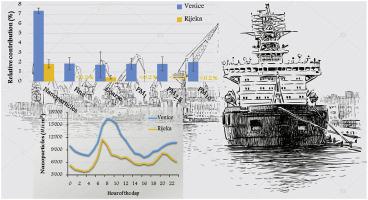Environmental Pollution ( IF 7.6 ) Pub Date : 2020-07-09 , DOI: 10.1016/j.envpol.2020.115175 E Merico 1 , M Conte 1 , F M Grasso 1 , D Cesari 1 , A Gambaro 2 , E Morabito 2 , E Gregoris 3 , S Orlando 2 , A Alebić-Juretić 4 , V Zubak 5 , B Mifka 6 , D Contini 1

|
Detailed information on in-harbour shipping contribution to size segregated particles in coastal cities are scarce, especially in the busy Mediterranean basin. This poses issues for human exposure and air quality in urban harbour agglomerates, where only criteria pollutants (i.e. PM10 and/or PM2.5) are usually monitored. In this work, particle number and mass size distributions, in a large size range (0.01–31 μm), were obtained in two coastal cities of northern Adriatic Sea: Venice (Italy) and Rijeka (Croatia). Three size ranges were investigated: nanoparticles (diameter D < 0.25 μm); fine particles (0.25<D < 1 μm), and coarse particles (D > 1 μm). Absolute concentrations were larger in Venice for all size ranges showing, using analysis of daily trends, a large influence of local meteorology and boundary-layer dynamics. Contribution of road transport was larger (in relative terms) in Rijeka compared to Venice. The highest contributions of shipping were in Venice, mainly because of the larger ship traffic. Maximum impact was on nanoparticles 7.4% (Venice) and 1.8% (Rijeka), the minimum was on fine range 1.9% (Venice) and <0.2% (Rijeka) and intermediate values were found in the coarse fraction 1.8% (Venice) and 0.5% (Rijeka). Contribution of shipping to mass concentration was not distinguishable from uncertainty in Rijeka (<0.2% for PM1, PM2.5, and PM10) and was about 2% in Venice. Relative contributions as function of particles size show remarkable similitudes: a maximum for nanoparticles, a quick decrease and a successive secondary maximum (2–3 times lower than the first) in the fine range. For larger diameters, the relative contributions reach a minimum at 1–1.5 μm and there is a successive increase in the coarse range.
Size distributions showed a not negligible contribution of harbour emissions to nanoparticle and fine particle number concentrations, compared to PM2.5 or PM10, indicating them as a better metric to monitor shipping impacts compared to mass concentrations (PM2.5 or PM10).
中文翻译:

比较亚得里亚海北部两个港口城市中船舶对尺寸分离颗粒浓度的影响。
沿海城市,特别是在繁忙的地中海盆地,缺乏港口运输对尺寸分离颗粒贡献的详细信息。这给城市港口聚集体中的人体暴露和空气质量带来了问题,在这些区域中,仅标准污染物(即PM 10和/或PM 2.5)通常会受到监控。在这项工作中,在亚得里亚海北部的两个沿海城市:威尼斯(意大利)和里耶卡(克罗地亚)获得了大尺寸范围(0.01-31μm)内的颗粒数量和质量尺寸分布。研究了三个尺寸范围:纳米颗粒(直径D <0.25μm);细颗粒(0.25 <D <1μm)和粗颗粒(D> 1μm)。使用每日趋势分析,威尼斯在所有规模范围内的绝对浓度都较大,这表明当地气象学和边界层动力学的影响很大。与威尼斯相比,里耶卡的公路运输贡献(相对而言)更大。航运业贡献最大的是威尼斯,这主要是因为船舶交通量较大。对纳米粒子的最大影响为7.4%(威尼斯)和1.8%(力耶卡),最小影响为1.9%(威尼斯)且小于0的精细范围。在粗级分1.8%(威尼斯)和0.5%(里耶卡)中发现2%(里耶卡)和中间值。运输对质量浓度的贡献与里耶卡的不确定性没有区别(对于PM,<0.2%1,PM 2.5和PM 10),在威尼斯约为2%。相对贡献与颗粒大小的关系显示出惊人的相似性:在细微范围内,纳米颗粒的最大值,快速减小和连续的次要最大值(比第一个值低2-3倍)。对于较大的直径,相对贡献在1–1.5μm处达到最小值,并且粗范围不断增加。
与PM 2.5或PM 10相比,尺寸分布显示港口排放物对纳米颗粒和细颗粒数浓度的贡献微不足道,表明与质量浓度(PM 2.5或PM 10)相比,它们是监测运输影响的更好指标。











































 京公网安备 11010802027423号
京公网安备 11010802027423号